The Quality of Rainwater Collected from Roofs and the Possibility of Its Economic Use
Abstract
1. Introduction
2. Materials and Methods
3. Results
3.1. Test Cycle Characteristics
3.2. Physical and Chemical Rainwater Quality
3.3. Heavy Metals in Rainwater
3.4. Microbiological Quality of Rainwater
4. Discussion
5. Conclusions
Author Contributions
Funding
Conflicts of Interest
References
- Orlińska-Woźniak, P.; Wilk, P.; Gębala, J. Water availability in reference to water needs in Poland. Meteorol. Hydrol. Water Manag. 2013, 1, 45–50. [Google Scholar] [CrossRef][Green Version]
- Szalinska, E. Water Quality and Management Changes Over the History of Poland. Bull. Environ. Contam. Toxicol. 2018, 100, 26–31. [Google Scholar] [CrossRef] [PubMed]
- Slyś, D. Potential of rainwater utilization in residential housing in Poland. Water Environ. J. 2009, 23, 318–325. [Google Scholar]
- Pochwat, K.; Słyś, D.; Kordana, S. The temporal variability of a rainfall synthetic hyetograph for the dimensioning of storm-water retention tanks in small urban catchments. J. Hydrol. 2017, 549, 501–511. [Google Scholar] [CrossRef]
- Zhang, Y.; Grant, A.; Sharma, A.; Chen, D.; Chen, L. Alternative Water Resources for Rural 5 Residental Development In Western Austarlia. Water Resour. Manag. 2010, 24, 25–36. [Google Scholar] [CrossRef]
- Jones, M.P.; Hunt, W.F. Performance of rainwater harvesting systems in the southeastern United States. Resour. Conserv. Recycl. 2010, 54, 623–629. [Google Scholar] [CrossRef]
- Xing, Y.; Jones, P. In-situ monitoring of energetic and hydrological performance of a semi-intensive green roof and a white roof during a heatwave event in the UK. Indoor Built Environ. 2019. [Google Scholar] [CrossRef]
- Stec, A.; Kordana, S.; Slys, D. Analysing the financial efficiency of use of water and energy saving systems in single-family homes. J. Clean Prod. 2017, 151, 193–205. [Google Scholar] [CrossRef]
- Basinger, M.; Montalto, F.; Lall, U. A rainwater harvesting system reliability model based on nonparametric stochastic rainfall generator. J. Hydrol. 2010, 392, 105–118. [Google Scholar] [CrossRef]
- Stec, A.; Zelenakova, M. An Analysis of the effectiveness of two rainwater harvesting systems located in central eastern Europe. Water 2019, 11, 458. [Google Scholar] [CrossRef]
- Khan, S.T.; Baksh, A.A.; Papon, M.T.I.; Ali, M.A. Rainwater harvesting system: An approach for optimum tank size design and assessment efficiency. Int. J. Environ. Sci. Technol. 2017, 8, 37–43. [Google Scholar] [CrossRef]
- Kimani, M.W.; Gitau, N.A.; Ndunge, D. Rainwater Harvesting Technologies in Makueni County, Kenya. Int. J. Eng. Sci. 2015, 5, 39–49. [Google Scholar]
- Evans, C.A.; Harrison, T.; Coombes, P.J.; Dunstan, H.R.; Dunstan, R.H. Identifying the major influences on the microbial composition of roof harvested rainwater and the implications for water quality. Water Sci. Technol. 2007, 55, 245–253. [Google Scholar] [CrossRef] [PubMed]
- Zdeb, M.; Zamorska, J.; Papciak, D. Studying microbiology of rain water for of their use in economy. J. Ecol. Eng. 2016, 17, 203–208. [Google Scholar] [CrossRef]
- Gwezi, W.; Dunjana, N.; Pisa, C.; Taur, O.T.; Nyamadzawo, G. Water quality and public health risks associated with roof rainwater harvesting systems for potable supply: Review and perspectives. Sustain. Water Qual. Ecol. 2015, 6, 107–118. [Google Scholar] [CrossRef]
- Friedler, E.; Gilboa, Y.; Muklada, H. Quality of Roof-Harvested Rainwater as a Function of Environmental and Air Pollution Factors in a Coastal Mediterranean City (Haifa, Israel). Water 2017, 9, 896. [Google Scholar] [CrossRef]
- Despins, C.; Farahbakhsh, K.; Leidl, C. Assessment of rainwater quality from rainwater harvesting systems in Ontario, Canada. J. Water Supply Res. Technol. AQUA 2009, 58, 117–134. [Google Scholar] [CrossRef]
- Helmreich, B.; Horn, H. Opportunities in rainwater harvesting. Desalination 2009, 248, 118–124. [Google Scholar] [CrossRef]
- Rajni, K.; Rajasekhar, B. Assessment of bacterial pathogens in fresh rainwater and airborne particulate matter using Real-Time PCR. Atmos. Environ. 2012, 46, 131–139. [Google Scholar]
- Koszelnik, P. Atmospheric deposition as a source of nitrogen and phosphorus loads into the Rzeszow 5 reservoir, SE Poland. Environ. Prot. Eng. 2007, 33, 157–164. [Google Scholar]
- ISO 5667-8: 1993 Water Quality—Sampling—Part 8: Guidance on the Sampling of Wet Deposition; ISO: Geneva, Switzerland, 1993.
- Kotowski, A.; Kaźmierczak, B.; Dancewicz, A. Rainfall Modeling for Sewage Sizing, PAN, Warsaw. 2010. Available online: http://www.bartoszkazmierczak.pl/pliki/monografia1.pdf (accessed on 21 January 2020).
- Nosrati, K. Identification of a water quality indicator for urban roof runoff. Sustain. Water Qual. Ecol. 2017, 9–10, 78–87. [Google Scholar] [CrossRef]
- Leong, J.; Oh, K.S.; Poh, P.E.; Chong, M.N. Prospects of hybrid rainwater-greywater decentralized system for water 10 recycling and reuse: A review. J. Clean. Prod. 2017, 142, 3014–3027. [Google Scholar] [CrossRef]
- Bai, L.; Wang, Z. Anthropogenic influence on rainwater in the Xi’an City, Northwest China: Constrains from sulfur isotope and trace elements analyses. J. Geochem. Explor. 2014, 137, 65–72. [Google Scholar] [CrossRef]
- Xu, Z.F.; Wu, Y.; Liu, W.J.; Liang, C.S.; Ji, J.P.; Zhao, T.; Zhang, X. Chemical composition of rainwater and the acid neutralizing effect at Beijing and Chizhou city, China. Atmos. Res. 2015, 164–165, 278–285. [Google Scholar] [CrossRef]
- Naddeo, V.; Scannapieco, D.; Belgiorno, V. Enhanced drinking water supply through harvested rainwater treatment. J. Hydrol. 2013, 498, 287–291. [Google Scholar] [CrossRef]
- Ding, Q.; Schweige, R.A.; L’Heureux, M.; Battisti, D.; Po-Chedly, S.; Jonshon, N.; Blanchard Wrigglesworth, E.; Harnos, K.; Zhang, Q.; Estman, R.; et al. Influence of high-latitude atmospheric circulation changes on summertime Arctic sea ice. Nat. Clim. Chang. 1995, 7, 289–295. [Google Scholar] [CrossRef]
- Duncan, H.P. A Review of Urban Stormwater Quality Process; Cooperative Research Centre for Catchment Hydrology: Melbourne, Australia, 1995; ISBN 1-876-00606-4. [Google Scholar]
- Papciak, D.; Tchórzewska-Cieslak, B.; Pietrucha-Urbanik, K.; Pietrzyk, A. Analysis of the biological stability of tap water on basis of risk analysis and parameters limiting the secondary growth of microorganisms in water distribution system. Desalin. Water Treat. 2018, 117, 1–8. [Google Scholar] [CrossRef]
- Wolska, M. Biological stability of water in water distribution systems. The effect of water treatment trials. Environ. Prot. Eng. 2015, 41, 147–157. [Google Scholar]
- Lehtola, M.J.; Miettinen, I.T.; Keinanen, M.M.; Kekki, T.K.; Laine, O.; Hirvonen, A.; Vartiainen, T.; Martikainen, P.J. Microbiology, chemistry and biofilm development in a pilot drinking water distribution system with copper and plastic pipes. Water Res. 2004, 38, 3769–3779. [Google Scholar] [CrossRef]
- Lethola, M.J.; Miettinen, I.T.; Lampola, T.; Hirvonen, A.; Vartiainen, T.; Martikainen, P.J. Pipeline materials modify the effectiveness of disinfectants in drinking water distribution systems. Water Res. 2005, 39, 1962–1971. [Google Scholar] [CrossRef]
- Yu, J.; Kim, D.; Lee, T. Microbial diversity in biofilms on water distribution pipes of different materials. Water Sci. Technol. 2010, 61, 163–171. [Google Scholar] [CrossRef] [PubMed]
- Lehtola, M.J.; Laxander, M.; Miettinen, I.T.; Hirvonen, A.; Vartiainen, T.; Martikainen, P.J. The effects of changing water flow velocity on the formation of biofilms and water quality in pilot distribution system consisting of copper or polyethylene pipes. Water Res. 2006, 40, 2151–2160. [Google Scholar] [CrossRef] [PubMed]
- Chu, C.; Lu, C.; Lee, C. Effects of inorganic nutrients on the regrowth of heterotrophic bacteria in drinking water distribution systems. J. Environ. Manag. 2005, 74, 255–263. [Google Scholar] [CrossRef]
- Lee, M.; Tansel, B.; Balbin, M. Influence of residential water use efficiency measures on houshold water dem and: A four year longitudinal study. Resour. Conserv. Recycl. 2011, 56, 1–6. [Google Scholar] [CrossRef]
- Lee, J.Y.; Bak, G.; Han, M. Quality of roof–harvested rainwater – Comparison of different roofing 5 materials. Environ. Pollut. 2012, 162, 422–429. [Google Scholar] [CrossRef] [PubMed]
- Lai, Y.H.; Ahmad, Y.; Yusoff, I.; Bong, C.W.; Kong, S.Y. Effects of roof pitch gradient and material to harvested rainwater quality. IOP Conf. Ser. Mater. Sci. Eng. 2018, 401. [Google Scholar] [CrossRef]
- Mendez, C.B.; Klenzendorf, J.B.; Afshar, B.R.; Simmons, M.T.; Barrett, M.E.; Kinney, K.A.; Kirisits, M.J. The effect of roofing material on the quality of harvested Rainwater. Water Res. 2011, 45, 2049–2059. [Google Scholar] [CrossRef]
- Turkum, A.; Peke, Y.H.; Tuncel, G. Investigating relationships between aerosol and rainwater compositions at different locations in Turkey. Atmos. Res. 2008, 89, 315–323. [Google Scholar] [CrossRef]
- Gikas, G.D.; Tsihrintzis, V.A. Assessment of water quality of first-flush roof runoff and harvested rainwater. J. Hydrol. 2012, 466–467, 115–126. [Google Scholar] [CrossRef]
- Lee, J.Y.; Yang, J.-S.; Han, M.; Choi, J. Comparison of the microbiological anh chemical characterization of harvested rainwater and reservoir water as alternative water resources. Sci. Total Environ. 2010, 408, 896–905. [Google Scholar] [CrossRef]
- Chester, R.; Nimmo, M.; Corcoran, P.A. Rain water-aerosol trace metal relationships at cap ferrat: A coastal site in the Western Mediterranean. Mar. Chem. 1997, 58, 293–312. [Google Scholar] [CrossRef]
- Gunawardena, J.; Egodawatta, P.; Ayoko, G.A.; Goonetilleke, A. Atmospheric deposition as a source of heavy metals in urban stormwater. Atmos. Environ. 2013, 68, 235–242. [Google Scholar] [CrossRef]
- Yaziz, M.I.; Gunting, H.; Sapari, N.; Ghazali, A. Variations in rainwater quality from roof catchments. Water Res. 1989, 23, 761–765. [Google Scholar] [CrossRef]
- Vialle, C.; Sablayrolles, C.; Lovera, M.; Huau, M.C.; Jacob, S.; Montrejaud-Vignoles, M. Monitoring of water quality from roof runoff: Interpretation using multivariate analysis. Water Res. 2011, 45, 3765–3775. [Google Scholar] [CrossRef] [PubMed]
- Background Document for Development of WHO Guidelines for Drinking-water Quality WHO/SDE/WSH/03.04/17 Zinc in Drinking-Water. Available online: https://www.who.int/water_sanitation_health/dwq/chemicals/zinc.pdf (accessed on 21 January 2020).
- Zhang, Q.; Wang, X.; Hou, P.; Wan, W.; Li, R. Quality and seasonal variation of rainwater harvested from concrete, asphalt, ceramic tile and green roofs in Chongquing, China. J. Environ. Manag. 2014, 132, 178–187. [Google Scholar] [CrossRef]
- Llopart-Mascaró, A.; Ruiz, R.; Martínez, M.; Malgrat, P.; Rusiñol, M.; Gil, A.; Suárez, J.; Puertas, J.; del Rio, H.; Paraira, M.; et al. Analysis of rainwater quality: Towards sustainable rainwater management in urban environments—Sostaqua Project. In Proceedings of the 7th International Conference on Sustainable Techniques and Strategies in Urban Water Management (NOVATECH 2010), Lyon, France, 27 June–1 July 2010. [Google Scholar]
- Dobrowsky, P.H.; DeKwaadsteniet, M.; Cloete, T.E.; Khan, W. Distribution of indigenous bacterial pathogens and potential pathogens associated with roof-harvested rainwater. Appl. Environ. Microbiol. 2014, 80, 2307–2316. [Google Scholar] [CrossRef]
- Śmigielska, M. Zoonoses transmitted by birds, Undomesticated. Ornis Pol. 2010, 51, 149–162. [Google Scholar]
- Korzeniewska, E.; Filipowska, Z.; Gotkowska–Płachta, A.; Janczukowic, Z.W.; Ritkowski, B. Bacteriological pollution of the atmospheric air at the municipial and dairy Wasterwater Treatment Plant area and in its surroundings. Arch. Environ. Prot. 2008, 34, 13–23. [Google Scholar]
- Ekstrom, S.; Noziere, B.; Hultberg, M.; Alsberg, T.; Magner, J.; Nilsson, E.D.; Artaxo, P. A possible role of ground-based microorganisms on cloud formation in the atmpsphere. Biogeosciences 2010, 7, 387–394. [Google Scholar] [CrossRef]
- Cho, B.C.; Hwang, C.Y. Prokaryotic abundance and 16S rRNA gene sequences detected in marine aerosols on the East Sea (Korea). FEMS Microbiol. Ecol. 2011, 76, 327–341. [Google Scholar] [CrossRef]
- Polymenakou, P.N. Atmosphere: A Source of Pathogenic or Beneficial Microbes? Atmosphere 2012, 3, 87–102. [Google Scholar] [CrossRef]
- World Health Organization (WHO). Manganese in Drinking-Water Background Document for Development of WHO Guidelines for Drinking-Water Quality© World Health Organization 2011; WHO: Geneva, Switzerland, 2011. [Google Scholar]
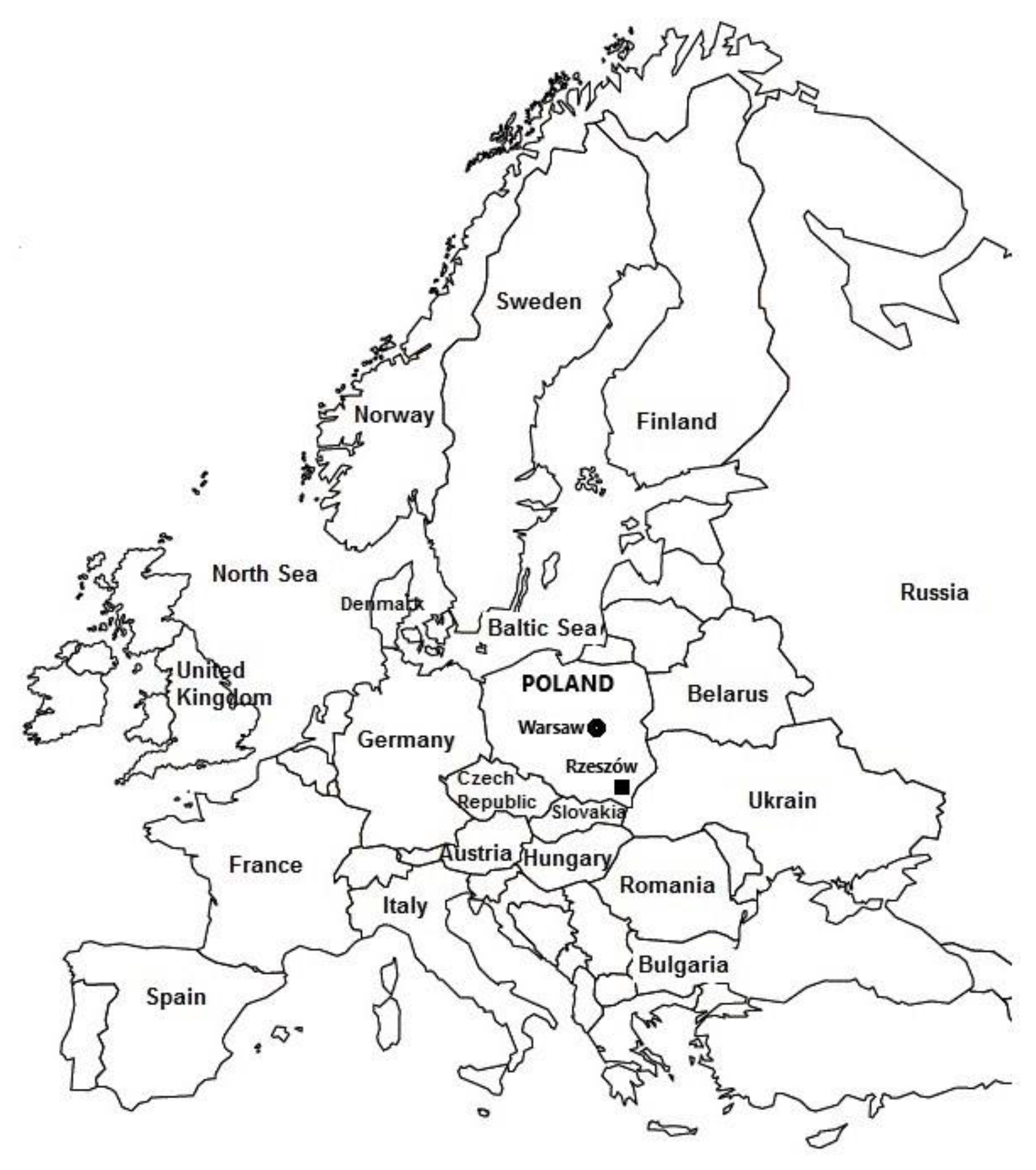

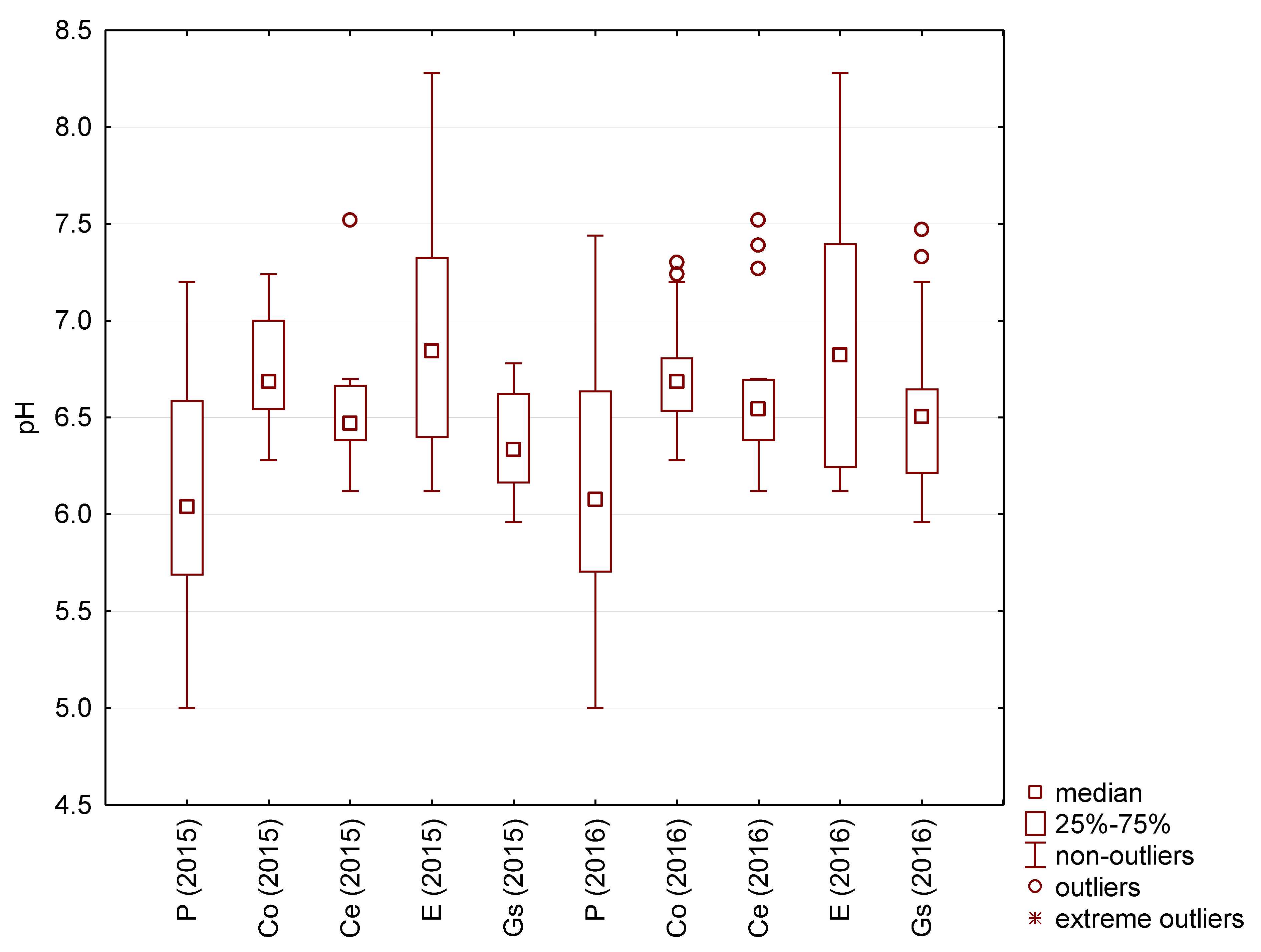
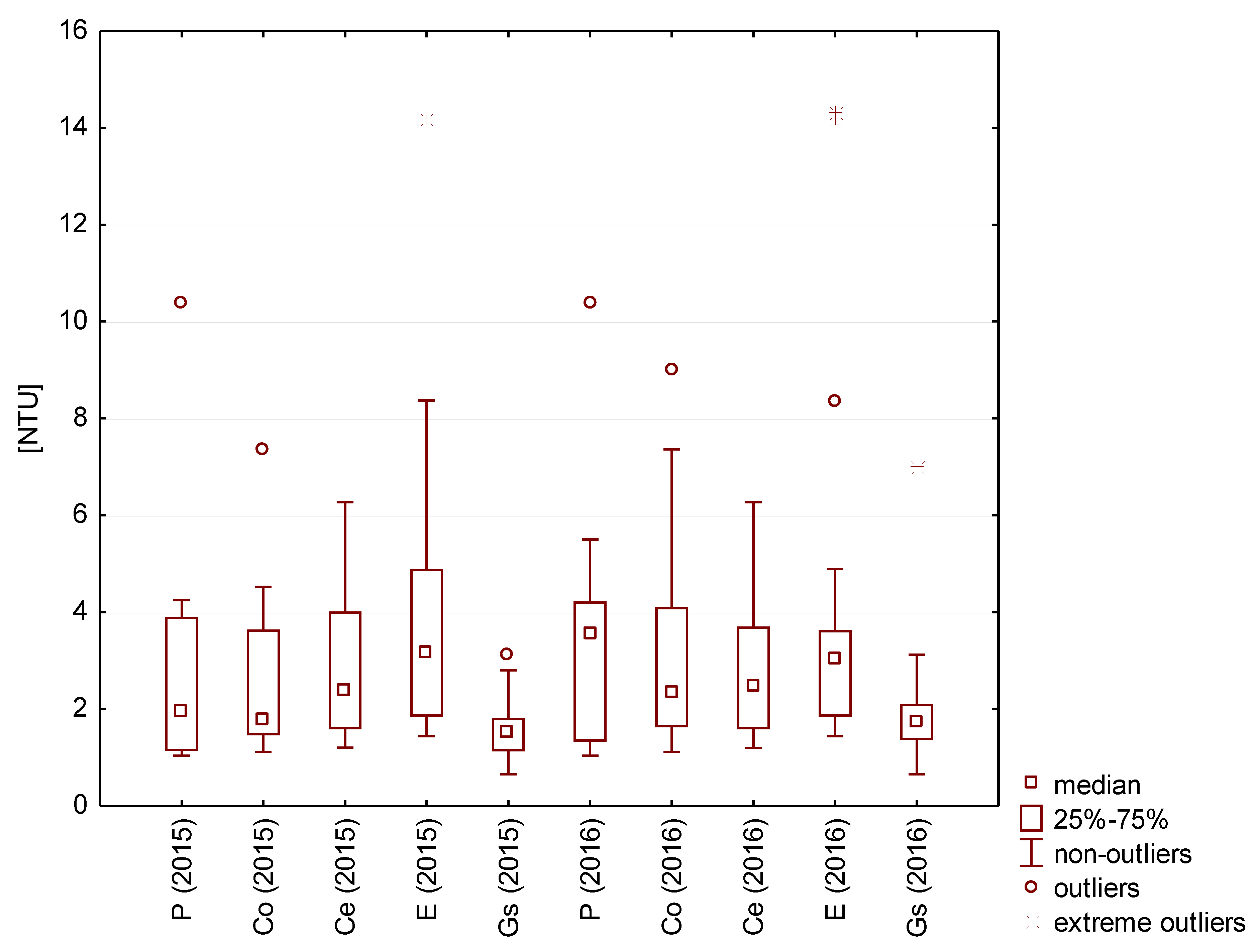
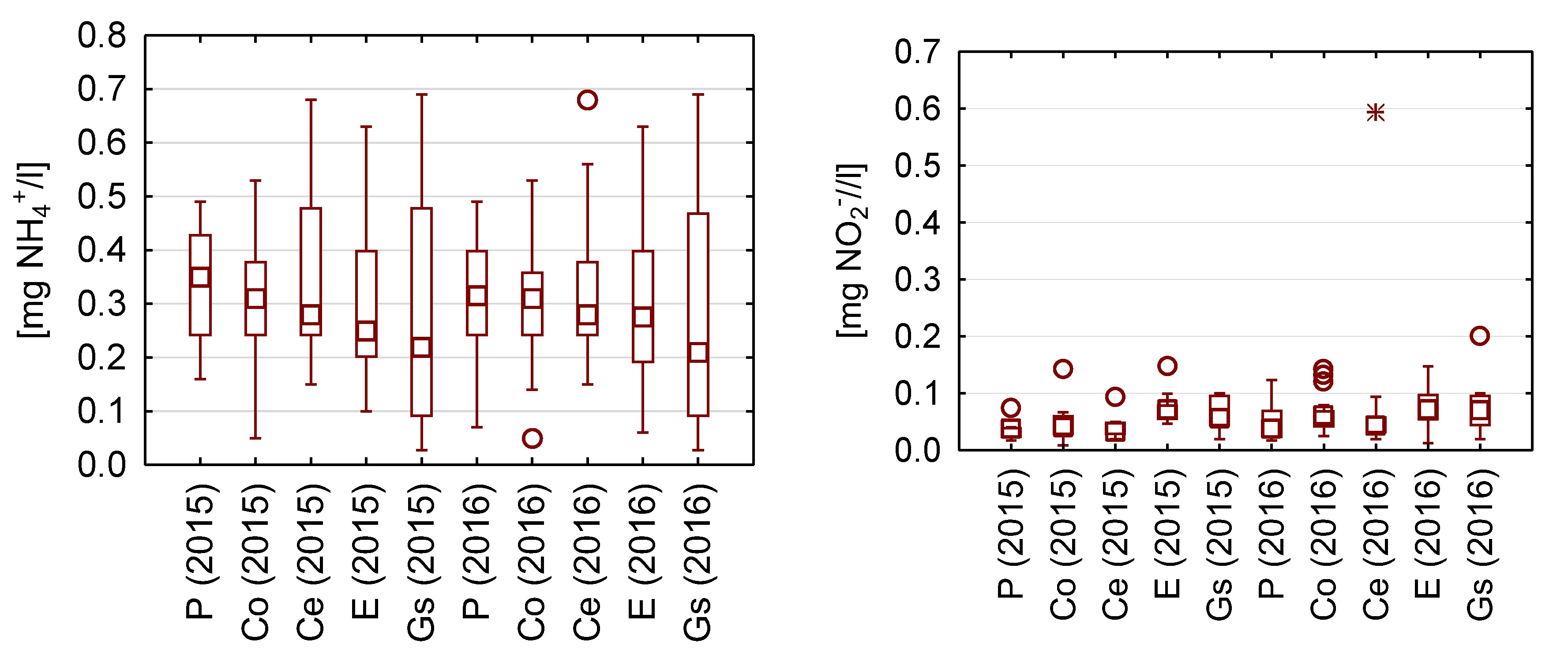
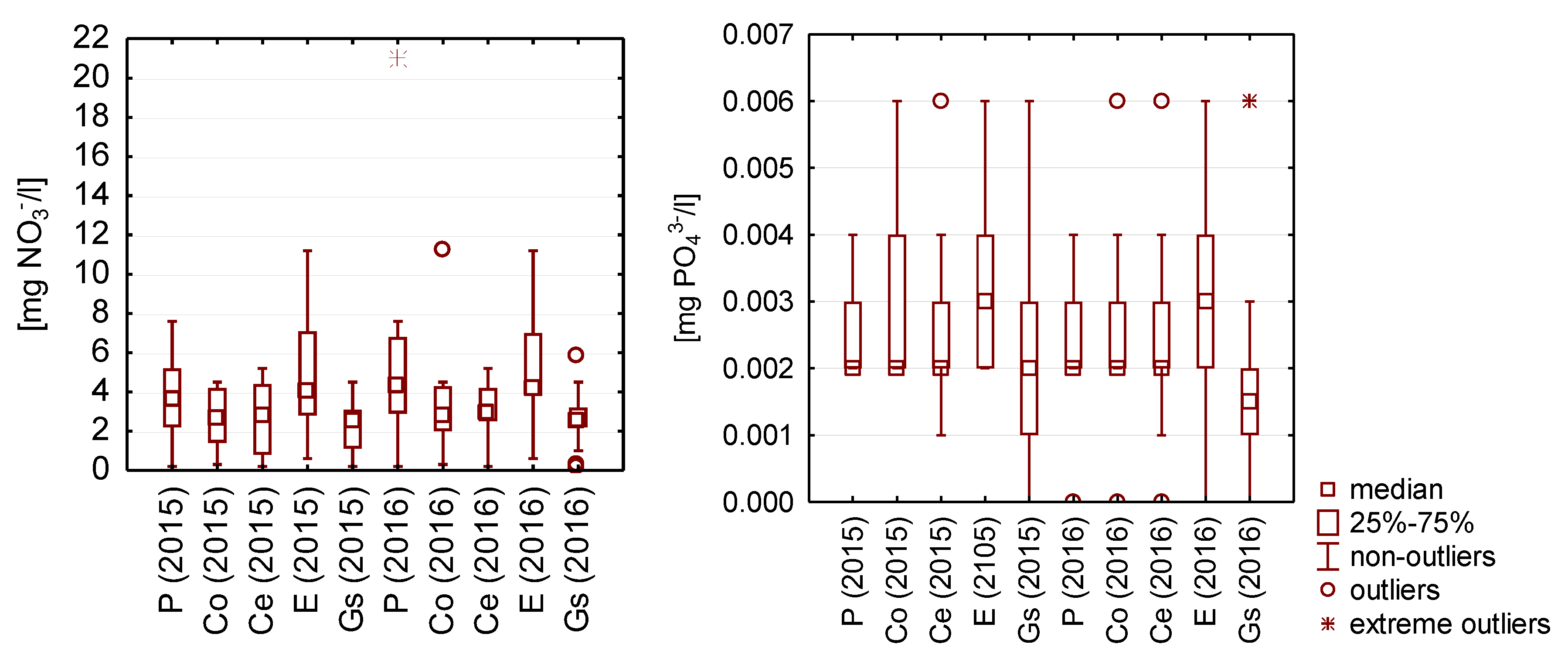
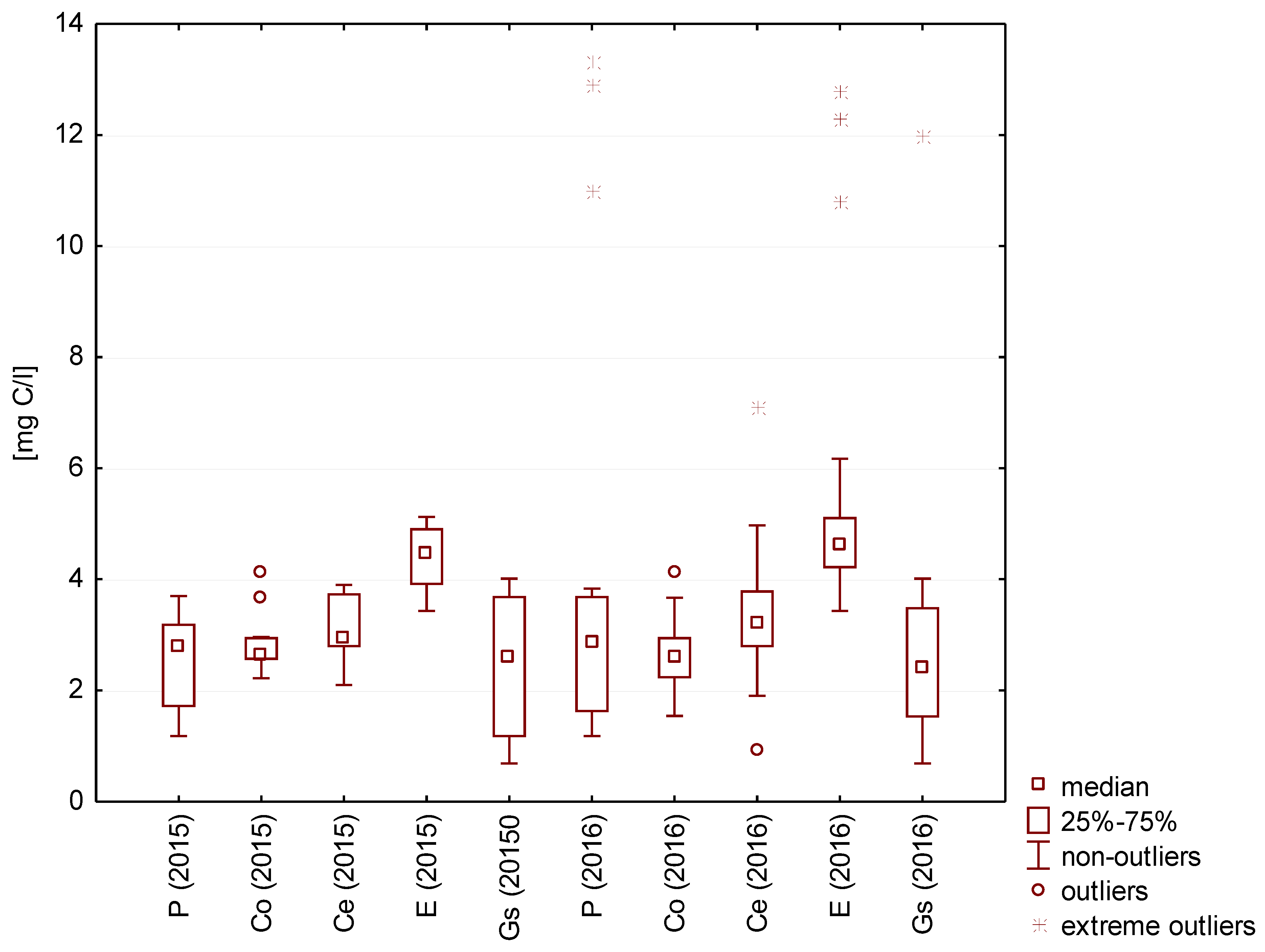
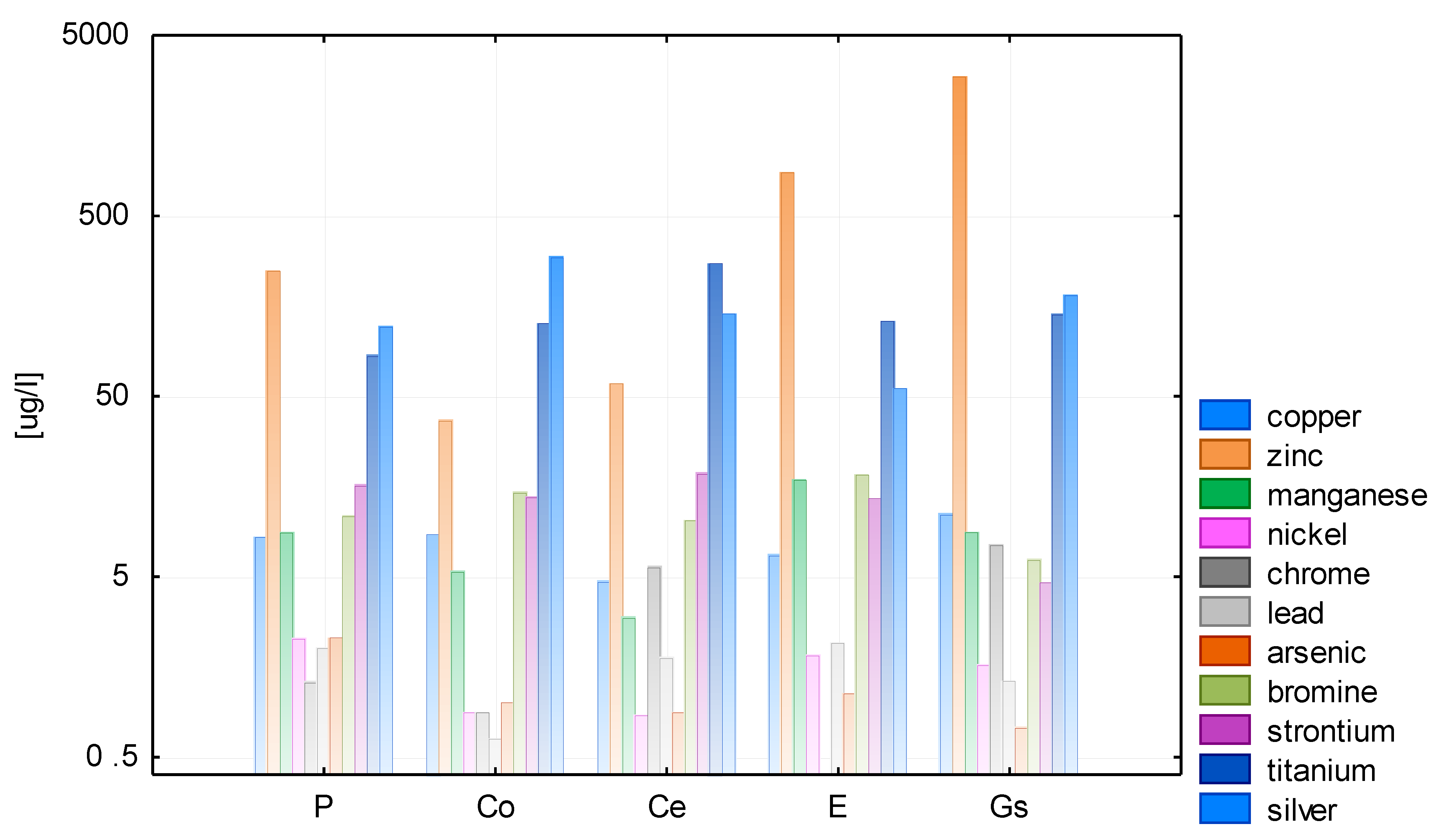
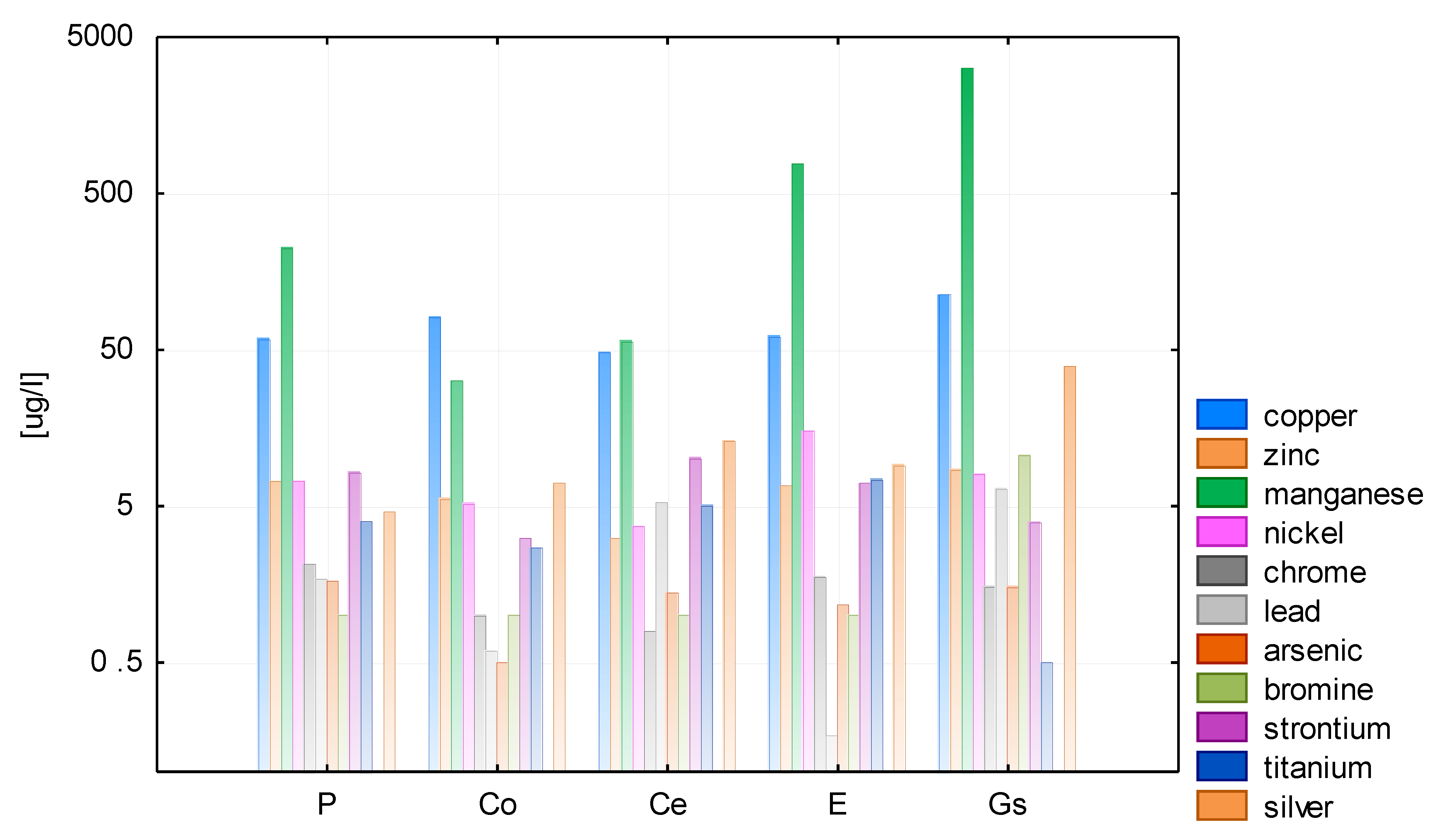
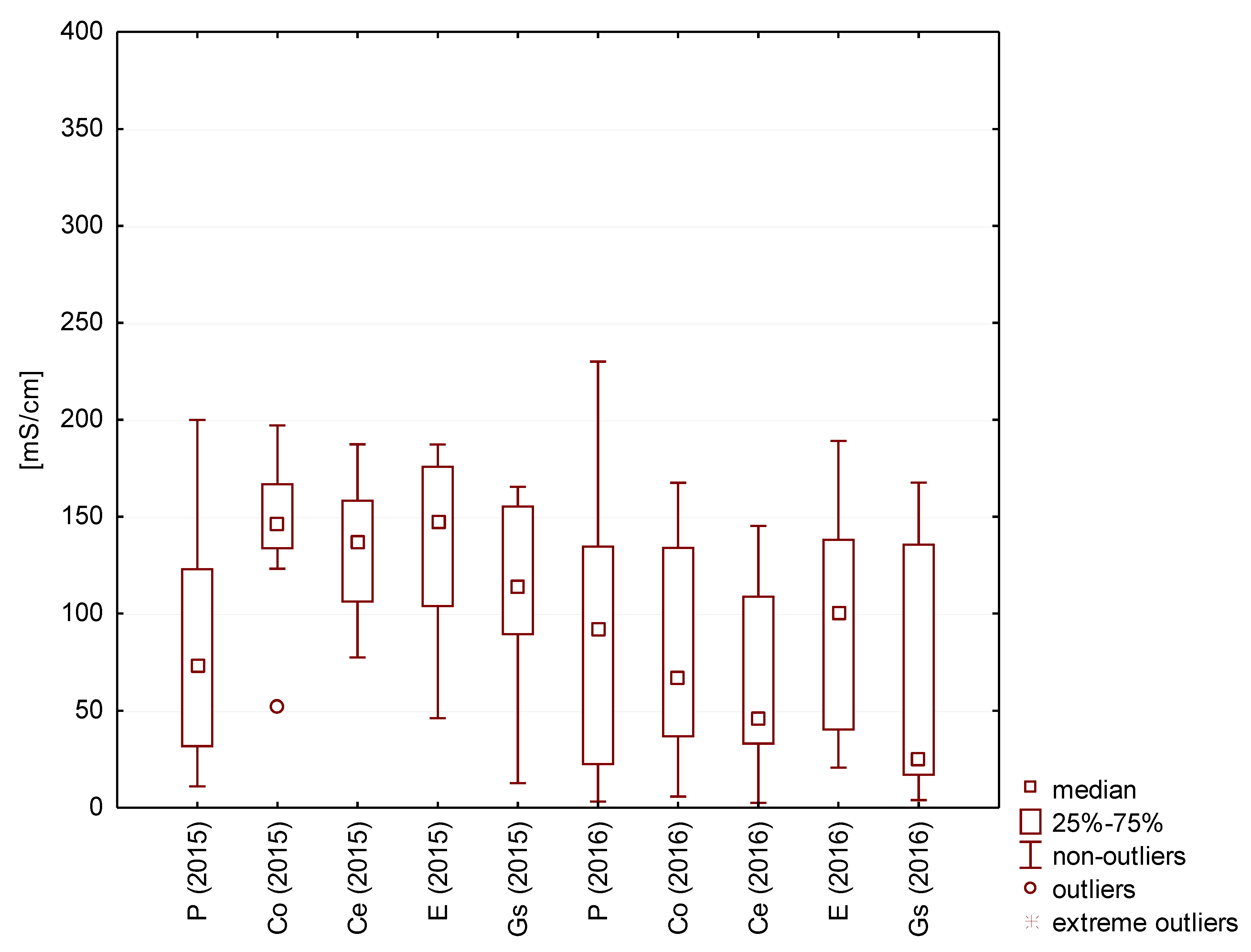
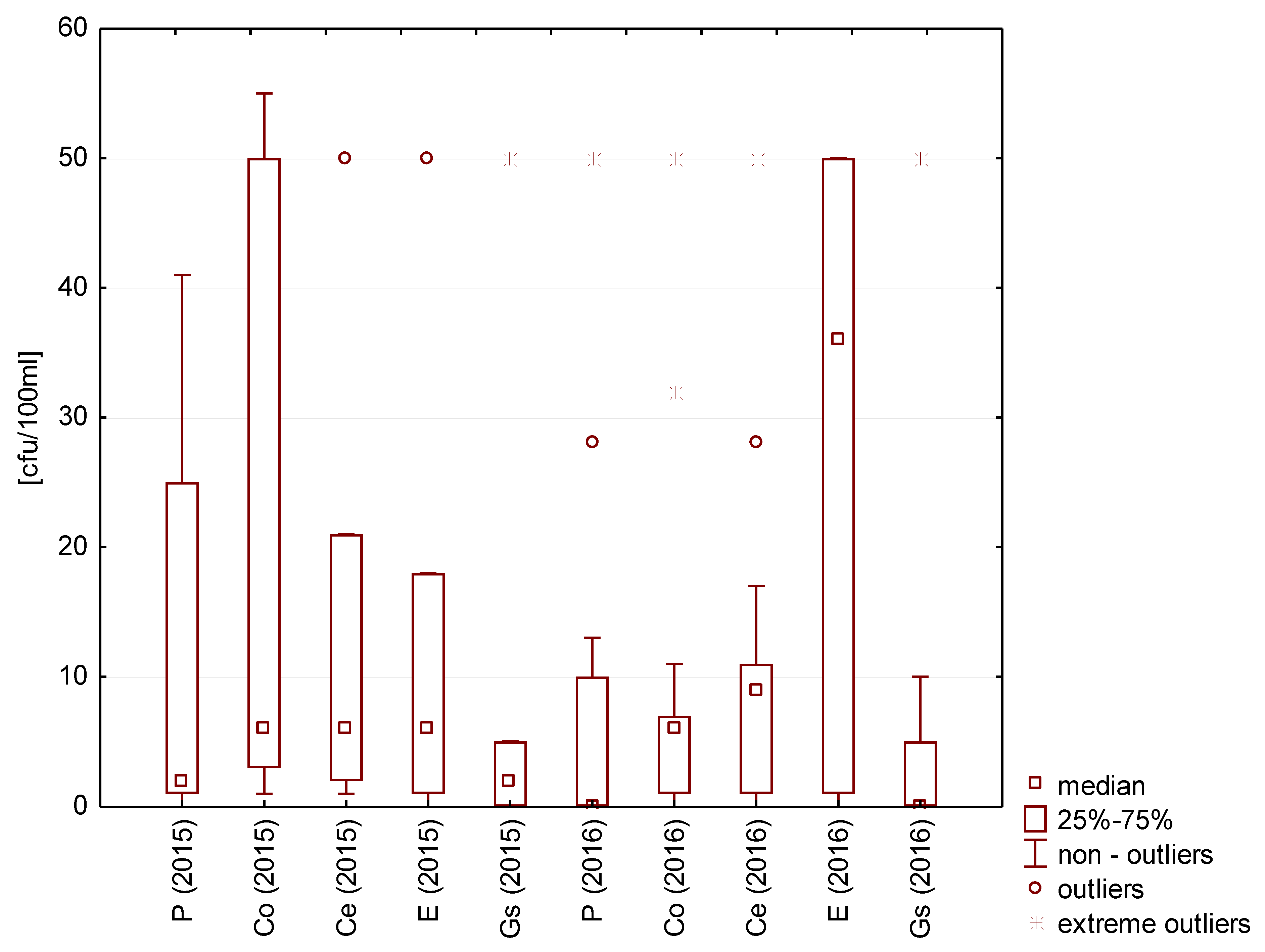

| Duration of Rain (min) | Number of Bacteria (cfu/mL) | Turbidity (NTU) * | ||||
|---|---|---|---|---|---|---|
| Mesophilic | Psychrophilic | |||||
| Rainwater Directly from Atmospheric Precipitation | Rainwater from a Roof Covered with Concrete Tiles | Rainwater Directly from Atmospheric Precipitation | Rainwater from a Roof Covered with Concrete Tiles | Rainwater Directly from Atmospheric Precipitation | Rainwater from a Roof Covered with Concrete Tiles | |
| 1 | 105 | 101 | 1206 | 1600 | 7 | >10 |
| 2 | 89 | 50 | 997 | 1267 | 4 | 5 |
| 3 | 75 | 55 | 512 | 1210 | 4 | 3 |
| 4 | 10 | 78 | 610 | 1300 | 5 | 3 |
| 5 | 69 | 26 | 486 | 1200 | 4 | 2 |
| 10 | 55 | 20 | 212 | 840 | 3 | 2 |
| 20 | 60 | 25 | 155 | 613 | 3 | 2 |
| 30 | 80 | 30 | 178 | 500 | 3 | 2 |
| Parameter | Method/Standard |
|---|---|
| pH | Electrometric method; EN ISO 10523: 2012 |
| Conductivity | Electrometric method; EN 27888: 1999 |
| Turbidity | Nephelometric method; EN ISO 7027: 2003 |
| Ammonium ion, nitrite nitrogen, nitrate nitrogen, phosphates | Ion chromatography method; EN ISO 10304-1: 2009 |
| General organic carbon (TOC *) | Analyzer TOC Sievers 5310 C; EN 1484: 1999 |
| Heavy metals: Copper, lead, chromium, nickel, zinc; trace elements: Arsenic, titanium, bromine, strontium | X-ray spectrometry method; procedures for equipment PICOFOX |
| The number of Escherichia coli bacteria | The membrane filter method; EN ISO 9308-1:2004 |
| The number of Enterococcus | The membrane filter method; EN ISO 7889-2:2004 |
| Characteristic | Year 2015 | Year 2016 |
|---|---|---|
| The number of rain events | 31 | 48 |
| The number of rain events analyzed | 11 | 23 |
| Total precipitation from research months (mm) | 254 | 413 |
| Average air temperature in spring (°C) | 12.3 | 12.2 |
| Average air temperature in the summer (°C) | 24 | 19.5 |
| Average air temperature in autumn (°C) | 10.5 | 15.1 |
| The longest break between precipitation (days) | 40 | 27 |
| Months with rainfall over 40 mm | III | IV, V, VII, IX, XI |
© 2020 by the authors. Licensee MDPI, Basel, Switzerland. This article is an open access article distributed under the terms and conditions of the Creative Commons Attribution (CC BY) license (http://creativecommons.org/licenses/by/4.0/).
Share and Cite
Zdeb, M.; Zamorska, J.; Papciak, D.; Słyś, D. The Quality of Rainwater Collected from Roofs and the Possibility of Its Economic Use. Resources 2020, 9, 12. https://doi.org/10.3390/resources9020012
Zdeb M, Zamorska J, Papciak D, Słyś D. The Quality of Rainwater Collected from Roofs and the Possibility of Its Economic Use. Resources. 2020; 9(2):12. https://doi.org/10.3390/resources9020012
Chicago/Turabian StyleZdeb, Monika, Justyna Zamorska, Dorota Papciak, and Daniel Słyś. 2020. "The Quality of Rainwater Collected from Roofs and the Possibility of Its Economic Use" Resources 9, no. 2: 12. https://doi.org/10.3390/resources9020012
APA StyleZdeb, M., Zamorska, J., Papciak, D., & Słyś, D. (2020). The Quality of Rainwater Collected from Roofs and the Possibility of Its Economic Use. Resources, 9(2), 12. https://doi.org/10.3390/resources9020012







